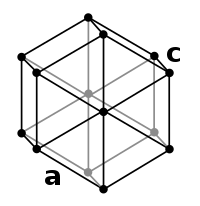
Photo from wikipedia
Abstract When discharge plasma was generated in an aqueous ammonia solution containing titanium dioxide (TiO2) powder, blue TiO2 was obtained. The blue TiO2 contained oxygen defects and Ti3+ formed by… Click to show full abstract
Abstract When discharge plasma was generated in an aqueous ammonia solution containing titanium dioxide (TiO2) powder, blue TiO2 was obtained. The blue TiO2 contained oxygen defects and Ti3+ formed by the plasma treatment; i.e., reducing species such as hydrogen radicals generated in situ during ammonia decomposition by plasma were considered to reduce TiO2. No marked changes in the crystallographic structure and specific surface area of TiO2 were observed after the plasma treatment, indicating that TiO2 was not exposed to high temperature. In addition, the plasma-treated TiO2 remained blue when exposed to air for several months. The photocatalytic activity of anatase TiO2 under visible light irradiation was enhanced after plasma treatment. In contrast, the plasma-treated rutile TiO2 showed inferior photocatalytic activity under visible light irradiation compared with that of the untreated rutile TiO2.
Journal Title: Applied Surface Science
Year Published: 2019
Link to full text (if available)
Share on Social Media: Sign Up to like & get
recommendations!